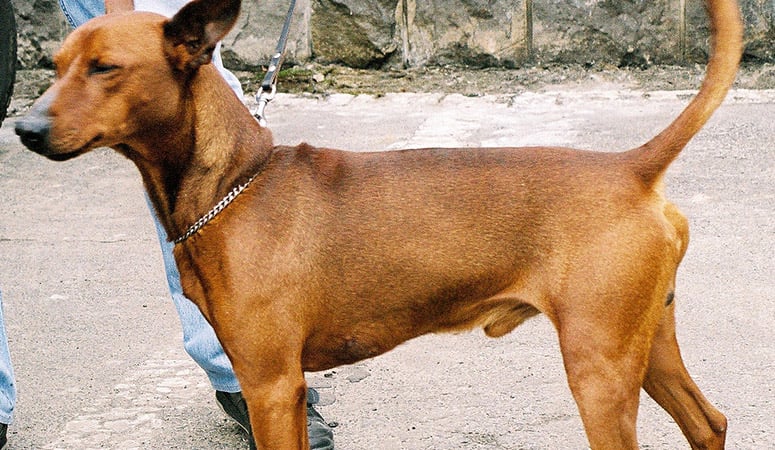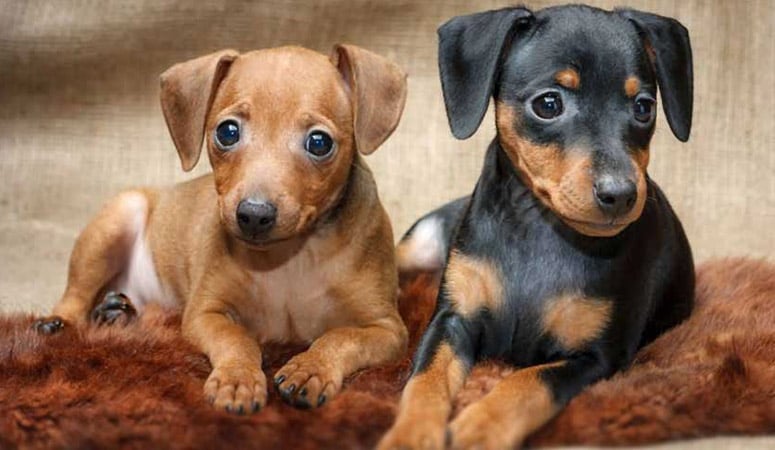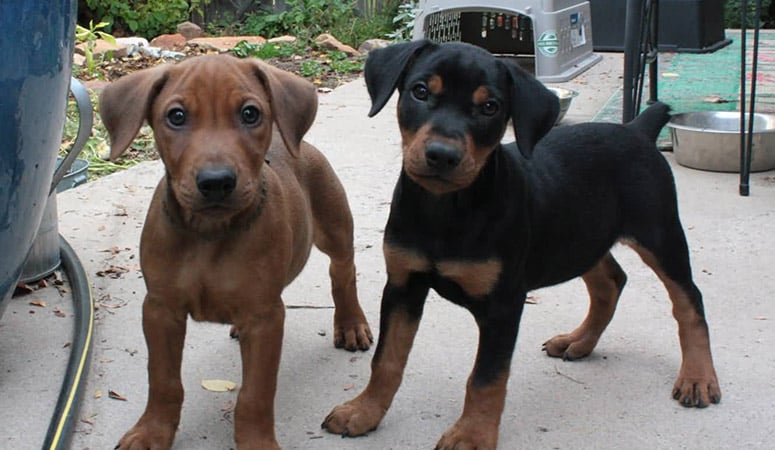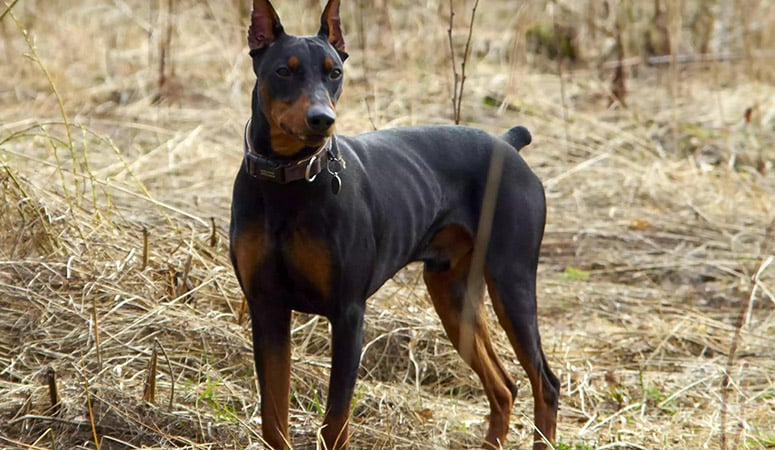German Pinscher
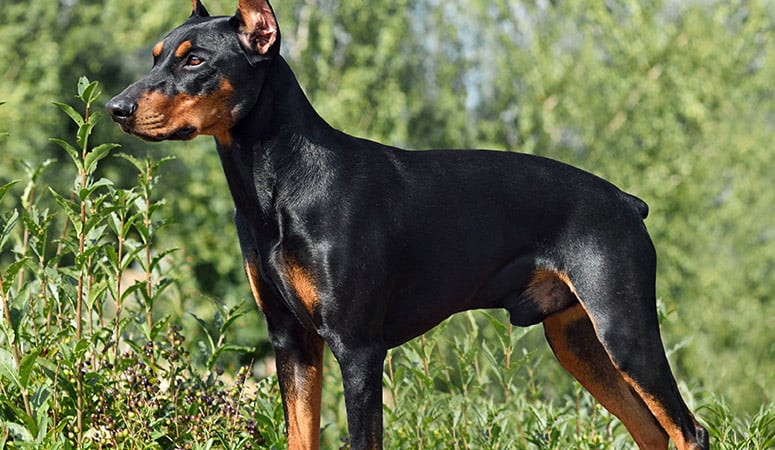
With medium-sized dog with and muscular square build, the German Pinscher is extremely agile, solid and strong. This breed was used as a rat catcher. As one of Germany’s oldest breeds and the prototype of other pinscher breeds, they are nice companion and watchdog of ideal size and loyal temperament today.
| Other Names | Deutscher Pinscher |
| Color | Black, Blue, Brown, Frown, Red, Red & Tan Markings, Red Markings, Tan Markings |
| Height | Males: 17-20 inches. Females: 17-20 inches. |
| Weight | Males: 25-45 pounds. Females: 25-45 pounds. |
| Life Span | 12-14 years |
| Personality | Courageous, Intelligent, Vivacious |
| Exercise | Needs Lots of Activity |
| Origin |
| Popularity | #123 |
| Groom Needs | Occasional Bath/Brush |
| Kids Friendly | Yes with supervision |
| Dog Friendly | Yes with supervision |
| Watch Dog | |
| Family Dog | |
| Litter Size | 6 to 8 puppies |
German Pinscher Pictures
German Pinscher Video
Introduction
The German Pinscher is a medium-sized dog with elegant features, a strong, square frame, and an elongated body. They are built as enduring and agile Pinschers. Formerly, they used to have their tails docked, upon the notion that it enhanced their speed, reduced their chances of contracting rabies, and strengthened their backs. Another common practice in some countries was the cropping of the ears to prevent injuries while they worked outdoors. However, all these practices have begun to fade and are considered as, more or less, illegal.
German Pinschers cone in fawn, blue and tan, red, or black and rust varieties. Some color varieties went extinct during the world wars, an example of such being the salt-and-pepper variety.
They are intelligent and walk with an elegance that pointed to confidence. Being medium-sized dogs, full-grown German Pinschers are much likely to stand 17-20 inches at the shoulder and tip the weighing scales somewhere around 25-45 pounds. They lead happy and fulfilled lives up to about 11-14 years when they are likely to die of age.
Living with German Pinscher
The German Pinscher is an average shedder and requires minimal grooming. Begin accustoming your German Pinscher to being brushed and examined when they’re a puppy. Make grooming a positive experience filled with praise and rewards, and you’ll lay the groundwork for easy veterinary exams and other handling when they’re an adult.
Brushing their coat with a cloth or rubber mitt about once a week will get rid of any excess hair.
Trim their nails once or twice a month if your dog doesn’t wear them down naturally to prevent painful tears and other problems. Handle their paws frequently–dogs are touchy about their feet.
Dog toenails have blood vessels in them, and if you cut too far you can cause bleeding–and your dog may not cooperate the next time they see the nail clippers come out. So, if you’re not experienced trimming dog nails, ask a vet or groomer for pointers.
Brush your German Pinscher’s teeth at least two or three times a week to remove tartar buildup and the bacteria that lurk inside it. Daily brushing will help more if you want to prevent gum disease and bad breath.
Their ears should be checked weekly for redness or a bad odor, which can indicate an infection, and then wipe them out with a cotton ball dampened with gentle, pH-balanced ear cleaner to help prevent infections.
German Pinschers need plenty of opportunity to stretch their legs—this includes playtime inside and time to run outside. Physical and mental exercise are top priorities for this energetic working breed, and without enough exercise the German Pinscher may become destructive or difficult to manage.
They excel at anything that challenges their considerable physical and mental abilities, including canine sports such as obedience, agility, rally, tracking, and barn hunts.
They’re not ideal apartment companions due to their exercise needs, but they may be able to adjust if there is easy access to a fenced outdoor area.
The breed isn’t meant to live outdoors full-time, and should not be chained outside, as this may open the door to aggressive behaviors. His attachment to family means he is not likely to adjust to a kennel situation.
They’re often playful, bordering on rambunctious, and are not happy cooped up indoors all day. They desire time and attention with their family.
With a high prey drive and a mind of his own, they should be supervised and kept leashed or allowed to run in a fenced area while German Pinschers enjoy time spent outdoors.
The puppies should not be given too much exercise because their joints and bones are still growing. Too much pressure on them could result in a few problems later on in their lives. Jumping up or off furniture or running up and down the stairs should not be allowed because these put too much pressure on their still growing joints and limbs.
The German Pinscher is a high-energy working breed, so they should be fed a high-quality commercial dog food diet formulated for dogs according to its size, age, activity level and metabolism. The general recommendation for how much high-quality dry dog food is one to two cups per day, split between two or three meals.
You should follow the feeding schedule to feed your Pinscher puppy. Feeding the same puppy food to avoid any tummy upsets. You can change a puppy’s diet, which can be done very gradually and always make sure they don’t develop any digestive upsets. If they do, it’s best to put them back on their original diet and to discuss things with the vet before attempting to change it again.
It’s best to feed a mature dog twice a day, once in the morning and then again in the evening, making sure it’s good quality food that meets all their nutritional requirements.
Obesity can shorten a dog’s life by several years so it’s important to keep an eye on their waistline from the word go. So it’s also important that dogs be given the right amount of exercise so they burn off any excess calories or they might gain too much weight which can lead to all sorts of health issues.
Clean, fresh water should be available at all times.
Learn about which human foods are safe for dogs, and which are not. Check with your vet if you have any concerns about your dog’s weight or diet.
German Pinschers are generally healthy, but just like all breeds, they can get certain conditions, such as hip dysplasia, hernias (often corrected during spay/neuter surgery) eye issues and Von Willebrand disease, etc. Some health problems don’t appear until a dog reaches full maturity.
Not all German Pinschers will get any or all of these diseases, but it’s important to be aware of them if you’re considering this breed.
There is a small incidence of heart problems, and some delayed post-vaccine complications have also been reported within the breed.
The teeth should be brushed often, using a toothpaste designed for dogs.
There are several health tests considerations specific to the breed, such as hip evaluation and ophthalmologist evaluation, Von Willebrand’s Disease DNA test and cardiac exam.
Responsible breeders test all breeding stock for conditions that can affect the breed. Regular visits to the vet for checkups and parasite control help to ensure the dog a long, healthy life.
Total Annual Cost: $2889
Cost is estimated for the first year and may vary depending on many factors, such as dog food, health care, leash, collar, licensing, possible fencing, crates, training and obedience classes, dog-walking, grooming, treats, toys, flea, tick, and heart-worm meds, microchips, etc.
German Pinschers are highly intelligent—so much so that they can be manipulative. This willful, mischievous breed requires lots of early socialization and obedience training.
The main challenge is to keep the German Pinscher interested and engaged. So they require a firm and knowledgeable owner, preferably with previous experience with other working dogs. Set—and enforce—boundaries from puppyhood to prevent the manipulative Pinscher from walking all over you.
The assertive German Pinscher needs a consistent owner who will dedicate time to his training.
Puppies should be properly socialized to develop the amiable, outgoing personality that is characteristic of the breed. They’re successful in performance and companion events such as earthdog, barn hunt, obedience, and agility.
Because these dogs are intelligent and hard-working they generally do well in dog sports – these sports can be a great source of supplemental exercise as well as mental stimulation.
The German Pinscher is a highly intelligent breed that learns quickly. Because these dogs can sometimes develop an independent streak, you should also plan to use positive-reinforcement training methods and maintain a firm and consistent hand in training throughout the dog’s life.
History
Formerly known as the Deutscher Pinscher, the German Pinscher is a medium-sized dog of German origin, one of the oldest dog breeds of the country. They have been ascribed to the ancestry of several dogs of German origin, including the Dobberman, Miniature Pinscher, Rottweiler, the Standard Schnauzer, and a few others. Thought to have descended from ancient guard and herd dogs of Europe, the German Pinscher has a fascinating history that probably dates back to the 17th century.
The Standard Schnauzer and German Pinschers were once considered as varieties of the same breed — the Standard Schnauzer regarded as the Wire Haired Pinscher while the German Pinscher was the Smooth-Haired variety. They were used as companions and guard dogs for traveling coaches in the day and homestead guards at night. They equally saw service in exterminating vermin, as they are reputed to possess such instinctive capability for ratting. The German Pinscher and the Standard Schnauzer were sired in the same litter before they were separated into two different breeds.
In the 1950s, after the separation had occurred with the emergence of a distinct breed known as the German Pinscher, there was no record of any litters for the breed. Werner Jung is credited with scouting for and retrieving member-dogs which continued the lineage of the German Pinscher breed in 1958. It wasn’t until the 1980s that the German Pinscher became known in the U.S, and subsequently breed fanciers founded an American breed club for it. The breed was later recognized by the American Kennel Club in 2003.
Helpful Information
Breed Club: GERMAN PINSCHER CLUB OF AMERICA
Breed Club Link: https://germanpinscher.org/
Breed Club Rescue: The German Pinscher Club of America Rescue
Breed Club Rescue Link: https://germanpinscher.org/rescue/

